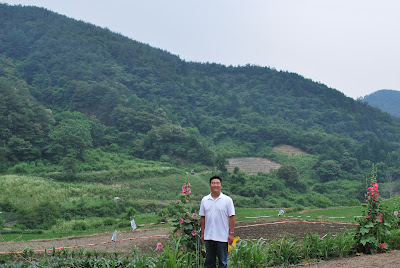 |
| Johang Ri village, where my ancestors lived 6 generations ago. I made it! |
This is the stuff of a book or movie someday. It is the Korean version of "Roots", only the setting is in an Asian context.
This past Saturday, my quest to find my family in Korea made a huge leap forward. As I was traveling on business, I recently had a chance to go meet with the Miryang Pak (밀양박) clan's board members in Jeonju (전주), which is a city in the middle part of Korea. A few months ago, my friend Julianne posted an English version of my family's genealogy record on a Korean website, and it had gotten a response from Pak Cheol Kyoon (박철균), the director of the Miryang Pak clan. We started to correspond over email and arranged to meet on a weekend when I was on a business trip to Seoul. That was last Saturday.
 |
| Yongsan train/subway station in Seoul. We took the KTX from Yongsan to Iksan. |
 |
| Arrival at Iksan Station via KTX |
He was very helpful and drove us to a lunch board meeting at a restaurant called Soldam Restaurant in Jeonju. We went upstairs for a lunch business meeting. They were discussing some business about planting trees to invest money on the Pak family property to take care of family burials and events. I only understood some of the discussion about the word tree (나무), and the fact that they were negotiating price with a local merchant. Business negotiations are universal in every language.
 |
| Miryang Pak (밀양박) clan's board member at a lunch meeting in Jeonju (전주) |
 |
| My friend Julianne helping to interpret with Pak Cheol Kyoon (박철균) |
 |
| Board members trying to decipher my great grandfather's name. |
 |
| I am trying best to follow the conversation and take some notes. My thought was "I had better keep studying Korean at Adroit College through the advanced class!" |
 |
| The "master jokpo" or "big book" that they compared my grandfather's jokpo with. |
Once the lunch meeting was concluded and I had said my farewells, Pak Cheol Kyoon (박철균) drove us to the mountains. On the way there, my friend Brian who lives in Jeonju joined us on the journey. After driving for a while, we stopped to ask an auntie for directions, and she joined us for the ride. Then we made it to a village called Johang Ri. This is where my ancestors lived amidst the rice paddies and bamboo forests nearby. It is hard to describe the feelings that I had, but let's just say I was overwhelmed. I had found my roots!
 |
| My friends Brian and Julianne...thank you! |
 |
| The center of the village at Johang Ri |
 |
| Mountains, rice fields, and farmland in Johang Ri |
 |
| I particularly enjoyed the bamboo forest and traditional Korean houses |
 |
| Working with Pak Cheol Kyoon for a photo session of my jokpo |
We didn't have much time to stay at the village nor to meet people there. I have since corresponded with Pak Cheol Kyoon (박철균) and he has a three day agenda for me when I am able to bring my father. I am looking forward to it! He is so energetic and so helpful, and the clan is lucky to have his leadership and spirit. I really appreciate the time he spent to help!
One issue of confusion was the name of my great grandfather. I called back to the US to ask my dad but he did not know. There was a diagram of the generations from 1-29 in the documents that came along with the jokpo, and afterwards I think that I found a clue on the name of my great grandfather. We think it is as follows:
27 generation
great grandfather
박정진 (righteous and true, official name in jokpo)
박군일 (everyday name)
grandmother is 전주 이씨 (like miryang pak)
grave is in jeonju
hyun/smart, 현
After the meeting last Saturday, my business partner in Korea, In Tai, was very helpful in explaining some of the genealogy from the Hangul part of the family tree. It turns out that his grandmother is from the 밀양박 line too. He was able to help me piece the information above together about my great grandfather.
I'll post more details of my findings as I have time. So for now, thank you to everyone and Happy Fourth of July 2012!
-Ron

No comments:
Post a Comment